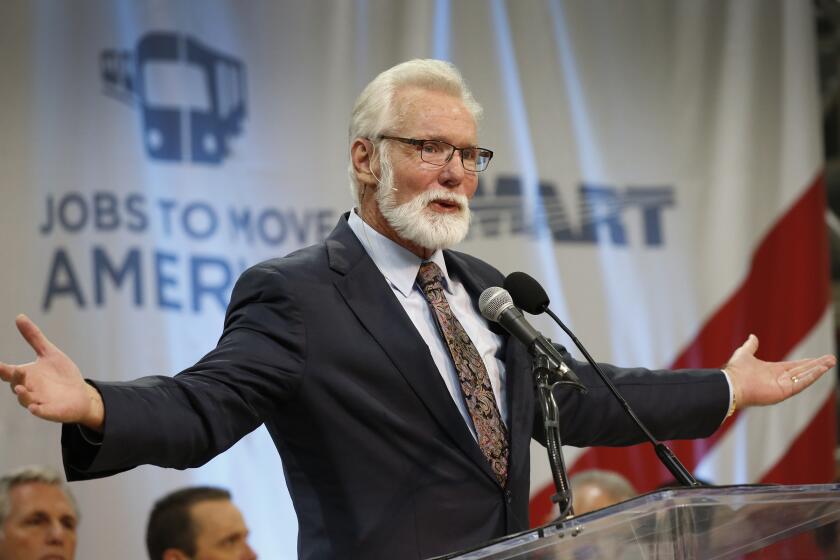Six years after the state came in to save Inglewood Unified, the district faces a budget crisis, buildings in disrepair and lack of steady leadership

- Share via
When Eugenio Villa agreed to return to the Inglewood schools for a second tour last summer, he knew the district remained one of California’s most troubled.
Inglewood Unified had been nearly insolvent when it was taken over by the state Department of Education in 2012. Six years later, its enrollment was still declining. Its school buildings were tired — some edging into decrepitude. Its test scores and graduation rates were still below the state average. And the public was out of patience.
Still, Villa, who had signed back on as the district’s chief business official, was shocked at what he found when he arrived in June 2017. Two years earlier, he had left the school system on what he thought was firm ground.
“Embattled Inglewood Unified School District finally balances the books,” read a 2015 headline in the Daily Breeze.
But it had all been wiped away.
The district was staring at an $8.1-million budget shortfall brought on by a series of major errors in revenue and spending projections that, in retrospect, had little connection to reality. By Villa’s estimate, Inglewood was about a year away from running out of cash.
“I walked in knowing it was going to be a challenge,” he said in a recent interview. “What took everyone aback was the scale of the problem.”
When the California Department of Education stepped in to save Inglewood’s schools after decades of mismanagement, it had a mandate to bring financial stability. Instead, the district has cycled through three leaders — not including interim appointees — chosen by Supt. of Public Instruction Tom Torlakson. None has stayed long. The chaos of constant turnover has contributed to uncertainty over whether the school system still can be saved.
“At this point, parents are blaming the state,” said Maria Gray-McKinley, president of the council that oversees Inglewood’s parent teacher associations. “Not one of these people they’ve put in charge of us has made any serious impact. We’re just going down, down, down.”
Torlakson appointed the current leader, former Los Angeles Unified administrator Thelma Meléndez de Santa Ana, in July. She replaced Vincent Matthews, who led the district for less than two years before becoming superintendent of San Francisco Unified.
A recent report by the state’s Fiscal Crisis and Management Assistance Team found that, under Matthews, Inglewood had left day-to-day tasks to consultants, hadn’t monitored its budget and had underestimated its salary costs by about $1 million. The district had also overestimated its revenue, in part by incorrectly counting the number of students.
The same report also said that although the district has at its disposal tens of millions of dollars earmarked for facility upgrades, very little has been spent on the many school buildings in need of serious repair. “Turnover in leadership has resulted in project delays,” it said.
In an interview, Matthews said he became aware of a probable budget shortfall only after he left the district in May. The California Department of Education and the Los Angeles County Office of Education are required to review Inglewood’s finances several times a year, Matthews said, and both agencies had approved the district’s budget, apparently unaware of the flawed projections.
“All I can tell you is we thought it looked good,” he said. “The CDE said it was good. And the county said it was good.”
Asked to explain how Inglewood fell into a budget crisis while under state control, Bill Ainsworth, a spokesman for the California Department of Education, attributed the shortfall to “overly optimistic enrollment projections” and the rising cost of special education services.
“District finances also continue to be strained as a result of declining enrollment and the increasing number of the district’s students enrolling in charter schools,” Ainsworth wrote in a statement that admitted no error or responsibility on the state’s part.
Margo Minecki, a spokeswoman for the county, said the Office of Education had relied on Inglewood’s estimates when it approved the district’s budget. “We have been diligent in identifying areas of concern and providing guidance on addressing these issues,” she said in a statement.
Read more: Can Inglewood’s NFL-fueled turnaround be a success if its schools are failing? »
Inglewood Unified’s enrollment has declined by more than one-third in the last decade, an extreme example of trends manifesting in districts all over the state. Falling birthrates, gentrification and charter school growth have hollowed out its schools, prompting some parents and teachers to call for a moratorium on new charter school openings.
The district now has about 9,000 students, and its own estimates suggest it could lose an additional 1,000 in the next two years. Some of its 18 schools are half-empty. Its two high schools, each built to hold about 2,000 students, serve roughly 800 apiece.
As the district loses students overall, the percentage of its students who qualify for expensive special education services is growing. About 18% of Inglewood Unified students meet this criteria, compared with 12% of Los Angeles County students.
Turning around any school district in such straits would be difficult, but Inglewood Unified is caught in a particularly destructive cycle. In California, public school funding is linked to enrollment, and the district’s slide has lost it millions of dollars. Part of its response has been to cut after-school programs and extracurricular offerings that had attracted families, giving them new reasons to leave.
The district also has to pay back the state about $1.8 million a year to cover an emergency loan, putting more strain on its $130-million annual budget.
Deeper cuts are inevitable given the shortfall. The district has told about 60 teachers that they could be laid off next year. It has also reduced its contributions to administrative employees’ healthcare plans, requiring them to shoulder more of the cost. And it is trying to negotiate with its teachers union to make teachers absorb these costs too. For the average teacher, who makes about $77,000 a year, according to the Inglewood Teachers Assn., that would amount to a 7% pay cut.
Teachers have reacted with outrage. Earlier this month, a group of them rallied outside a board meeting, wearing buttons that read, “Not On Strike Yet,” the “not” and “yet” in tiny font.
“They spent money they didn’t have. Now they’re asking the teachers and classified staff to pay for it,” said teacher Ngozika Anyanwu, a member of the union’s bargaining team. “It’s flat-out disrespectful.”
Villa acknowledged that employee morale already is low and that a teacher strike is a real possibility.
“There’s no good that comes from this,” he said. “Except the need, and the need is to not go insolvent.”
Amid the gloom, Inglewood parents and teachers said that Meléndez and Villa have made moves that give them hope. Meléndez has distinguished herself from her predecessors in ways small (returning phone calls and answering emails, for example) and large.
Under her administration, Inglewood recently announced plans to do what has long been discussed but never acted on: merge Clyde Woodworth Elementary School and Albert F. Monroe Magnet Middle School. The consolidation, Villa said, will allow the district to remove portable classrooms, replace outdated facilities, and lease out newly available land — adding revenue at an opportune time when construction of an NFL stadium in Inglewood is raising property values.
He and Meléndez also plan to use the money available to fix school buildings. Inglewood Unified was awarded $44 million by Los Angeles International Airport as part of a noise mitigation program for schools in the flight path. It also has about $8 million for facility improvements remaining from a bond measure passed in 2012 and plans to issue bonds for an additional $30 million.
For parents like Gray-McKinley, whose five children have all attended Inglewood schools, watching the revolving door of state-appointed administrators has brought on crisis fatigue. She wonders if it will take a “miracle,” like loan forgiveness from the state or unexpected generosity from the incoming NFL teams, to give the district the means to make itself attractive to families again.
Yet in a short period, she said, she has seen glimmers of possibility under Meléndez. “Honestly,” Gray-McKinley said, “she’s the first one that follows through.”
Twitter: @annamphillips
More to Read
Sign up for Essential California
The most important California stories and recommendations in your inbox every morning.
You may occasionally receive promotional content from the Los Angeles Times.











